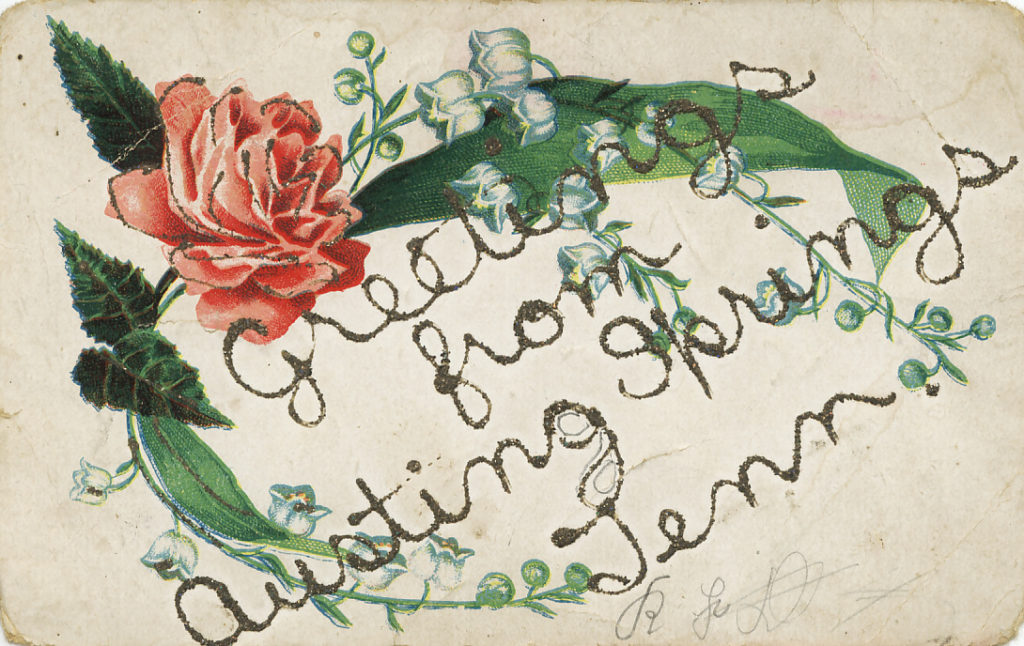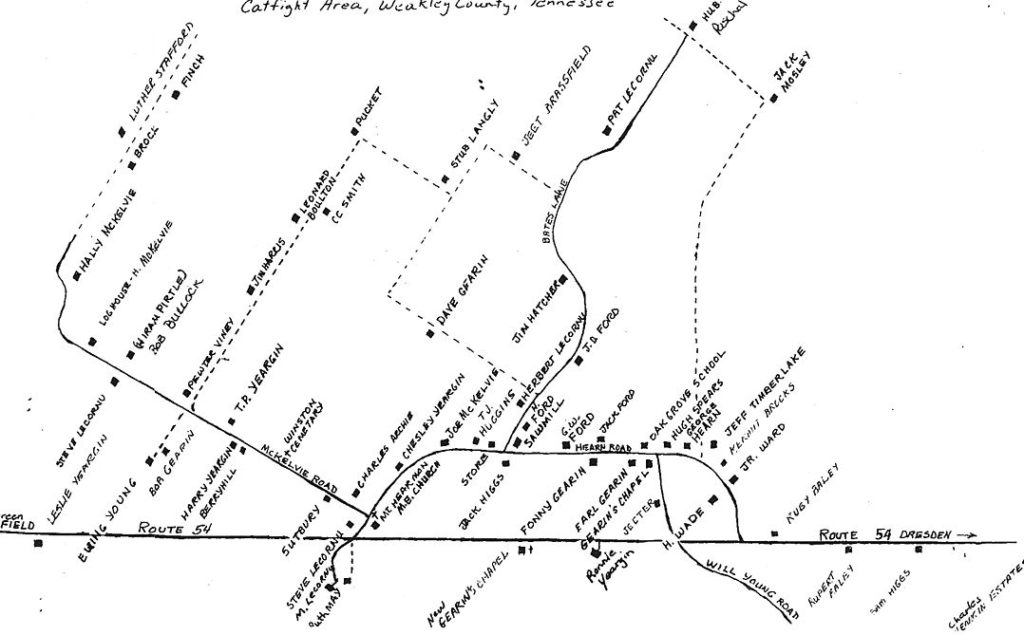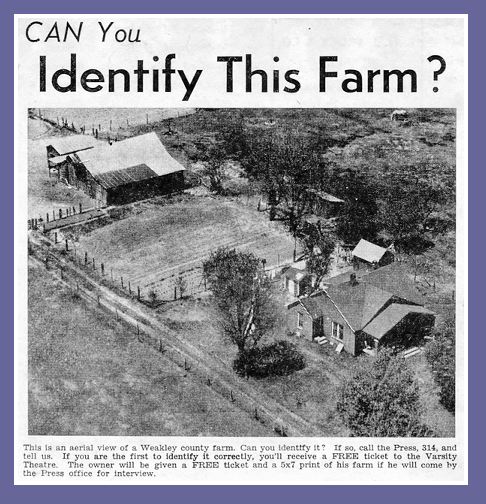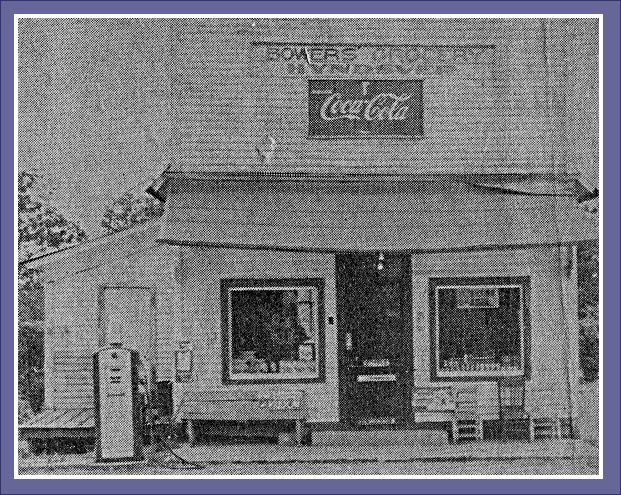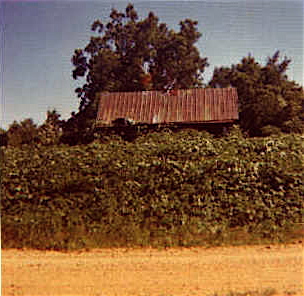Austin Springs, Northern Weakley, a little East of Dukedom
Old Story about White Lightnin’ in Weakley County
Old POSTCARD – See beautiful postcard Austin Springs early 1900’s

3 articles on the history of Austin Springs.
Bunis Westbrook lived in Austin Springs and was my grandfather. Chap Johnson was Bunis’s brother-in-law. Clyde Johnson was Chap’s brother. I visited my grandparents during the 50’s and remember the store and the barber shop. One thing I remember about the store was they overstocked on shoes from the 30’s and they sat on the shelves and never sold. The gas pump was always a gravity fed type pump and was still in operation in the 50’s. The cream station went out of business in the 30’s when Pet Milk began buying milk directly from the farmers. Bunis went to Fulton once a week to replenish the store with bread and feed. I made that trip with him many times. Submitted by David Wilkins
From the Fulton Daily Leader, Fulton, KY Tuesday, February 1, 1983.
Austin Springs Rivaled Other Health Spas
by Ouida Jewell
Mineral waters of Austin Spring, Tenn, resulted in a boom town health spa in the 1800s and early 1900s.
The town was named for Chris Austin, who purchased the land and soon discovered the springs on it. He shored up the sides of it and began telling his neighbors about his fortune. About this time it was thought healthful to drink the reddish-like water, when one felt the twinges of illness, whether real or imaginary. It was rivaled by springs resorts like Dawson Springs and Hot Springs, Ark. In a very short time, ‘Boom’, and a new town! Hotel, stores, campgrounds, lock-up jail, sawmill, grist-mill, barber shop, church, post office, lodge, saloon, blacksmith shop, etc.
People came for miles from Illinois, Indiana, Missouri and Kentucky, many by train to Fulton (first known as Pontotoc). They came by buggy, stage and horseback, staying for the weekend, or extended visits in the hotel, to drink the waters.
A town some 100 years ago, now gone, but the old curbing of one of the springs can be seen on the west side of Powell Creek. Also, remains of the barber shop, an old house, and a deserted gravity gas pump.
Many Sundays, large crowds covered the campgrounds and it was quite an affair. E.M. Coffman remembers as a boy attending and looking forward to seeing Ben Winston come driving up in his new shiny buggy, pulled by a fine bay horse. Riding in the buggy would be his good-looking girlfriend, Ruby Henderson. Ben was a sharp dresser and on of the most eligible bachelors of Dukedom, who wore his derby hat and spats and vest well. But the whole point was that Ben, the merchant, brought sacks of peppermint candy which he would give to the boys and girls. The campground and hotel was on the east side of the creek. Not to be daunted by dust, nor high water when Powell Creek was out, boardwalks connected the hotel and the businesses.
On Sundays there were as many as 500 visitors. And, for those that wanted drinks other than the red mineral waters, there was always plenty of “white lightning”.
The hotel was a two-story affair with balconies, rooms and a post office, The last in the hotel was Dewey Ainley. This magnificent structure burned in the 1930s. The early town had a small jail house, and when brawls would break out, they had their own deputy sheriff or constable. Tom Johnson, who owned one of the earlier stores, solved his own problems, chasing the brawler out with a plow point. Tales have it there were shootings. Seems that a young man’s mother heard shots one time and ran over where he lay dying. She put his head in her lap and asked who did it. He kept repeating in whispers his friend’s name, “Noah”, before he died. Noah was never tried.
There was not only the hotel in the campground with the beautiful grove of trees, there were three stores, owned by Tom Johnson, (later Chap and Clyde’s), Fount Gibson and George Harris. George sold ladies’ hats, caskets and groceries. He was a kidder too. Seems that when kids would come to buy sugar, he might send home clean white sand for the joke. Fount Gibson also ran a general store. Tom Johnson Store was a general merchandising store, handling groceries, dry goods, fencing, farm tools, shoes, overalls and later gasoline. King Rose moved there in early 1900s for health reasons for his first wife, Kittie Mae, operating a store for a time.
K.M. Winston remembers this store vividly as he and H.H. Nelson hauled ice (300 pounds) there weekly on their ice route in 1934. They also sold to the other stores.
Usually, a checker game was going. He also remembers Tom Johnson, Clyde, Chap and their families coming to Knob Creek Church of Christ in their early model Buick touring car. He also remembers their weekly trip through Dukedom in their 1928 Chevrolet truck to get their freight in Fulton. Before then, he thinks they hauled freight by wagon, George Cherry being one of the early teamsters. Austin Springs had a Baptist Church in town early known as Unity. Later the church moved, changing its name to Salem which still exists.
More about Austin Springs on Wednesday’s society page.
The Fulton Daily Leader, Fulton, Kentucky, Wednesday, February 2, 1983
Railroad Coming Ended Austin Springs Dream
By Ouida Jewell
The following is an article about Austin Springs continued from Tuesday’s society page.
Now what about the name Unity? When local folks first applied for a post office they were told another post office in Tennessee had already been given the name Austin Springs. Sept. 25, 1889, was the date that the first postmaster, A.M. McGuire applied and was granted the name “Unity”, however, the town remained Austin Springs. Postmasters were: A.M. McGuire, 1889-1893; Aaron W. Duke, 1893-1902; David A. Frields, 1902-1905. They never had any local routes, and on discontinuance, it was served by a Dukedom route.
Clyde Johnson remembered a John Stone bringing mail by mule back. Later by buggy and auto. On the old application, which Horard Harris, the postmaster of Dukedom now has, Austin Springs was located nine miles south of Cuba, eight miles southeast of Pilot Oak, slightly southeast, five miles of Dukedom, seven miles north of Palmersville, Tenn., seven miles northwest of Elms Tree, Tenn. (Bumpus Store), eight miles southwest of Boydsville, Tenn., and two miles southeast of Foy.
Seems Foy was located near Knob Creek on the Kentucky-Tennessee state line. This is where the first Knob Creek Church of Christ was established in 1832.
Not only Austins resided there, but other early names nearby were: Benjamin Farmer, Gibson, Murrel, Harris, True, Johnson, Frields, McGuire, Duke, Ainley, John Cavitt, Isaac and William Willingham, John Rogers, J.B. Davis, Peter Williams,. Marcus Austin, John Stephenson, Bethel, John and Jane Sims, McClain, Bynum, Rickman and many others which are not omitted intentionally.
Early arrivals in the northeast corner of Weakly County, 1820, were Henry Stunston and wife, Elizabeth Hancock Stunston. This was still part of Stewart County. They came from the Palmeto State (S.C.). The first white child born in Weakley County was born to Lewis Stunston and wife, Annie Simms. This is according to Goodspeed History (1887). Their location was about five miles northeast of Austin Springs.
The town had a barber shop, Bunis Westbrook cream station, Woodman of the World lodge, three groceries, blacksmith shop, Warren’s sawmill, and Frields grist mill in the 1930s.
The beautiful grove was lost due to flooding when it rained. The springs rose, flooding the flat land, hence the board walks. Only one store remained following World War II. Last to run the store were the Rickmans, but it soon closed and they moved to Murray. A family named Hall bought the town.
Nearby are the cemeteries: Acree, McGuire, Murrell, Harris, McClain, and Pinegar.
The dreams of making Austin Springs “the garden spot of the state” was lost with the coming of the railroads, highways, airlines and interstates. The town continued to die, until now all is gone except the weeds. The springs continue to flow. No one going to the place now can imagine that once it was a booming spa. Even the “medical” properties of this red water couldn’t save the spa, but the water
continues to bubble!
Much information for this article was given by Howard Harris, Clyde Johnson, Buddy Johnson, and K.M. Winston.
Article in the Dresden Enterprise, Dresden TN, Wednesday, July 27, 1983
much of this article appears to have been taken from the Fulton Newspaper
Although Northwest Tennessee has never been hailed as a tourist center in days gone by, right here in Weakley County, a small community by the name of Austin Springs was acclaimed far and wide as being the place to go to “get the cure for what ails ye.”
This was due to the fact that, at the time, (the late 1800’s through the early 1900’s) it was thought to be quite healthful to drink the water that flowed from a mineral spring there.
People came from, not only surrounding communities such as Dukedom and Fulton, but from as far away as Illinois and Missouri to receive the medicinal treatment that the iron-laden reddish water could provide.
According to a lifetime resident of the Austin Springs Community, Mrs. Ethel McClure, “for the first two or three days you drank the water, it had a funny taste, but after you got use to it, no other water tasted right.”
Mrs. McClure can also remember people bringing jars and bottles to the springs to get water to take home and drink. The one person that Mrs. McClure recalls more vividly was Jim Cy Cavender of Dukedom, “He would come in to the springs in a horse-drawn wagon and fill up several jugs to take home. It was the only spring water he drank.
Austin Springs was named after Chris Austin who purchased land in the early 1880’s and soon thereafter discovered the springs. He bricked up the sides and then began telling friends and neighbors of the elixir-like effect of the water that flowed freely from the springs. Today part of the curbing of the springs can still be seen on the west side of Powell Creek. The water has found a new outlet. It now flows openly into Powell Creek.
Shortly after Austin discovered the springs, a town began to emerge. The people who had first come to visit the springs liked the area so well that many of them settled there.
The businesses in Austin Springs were Tom Johnson’s General Store, later operated by sons, Chap and Clyde; Fount Gibsons’ General Store; George Harris’ General Store, a barber shop operated by Charlie Vincent; a blacksmith shop and Gristmill operated by Clarence Berryman; a cream station operated by Bunis Westbrook. There were also two hotels and a Woodman of the World lodge. (The businesses listed above were not all in existence at the same time, however, it is agreed that the Johnson Store was in business longer than its competitors).
There was also a saloon, a “lock-up” jail, a post office, and a sawmill.
There was a Baptist church near Austin Springs that was named Unity. That same church exists today under the name of New Salem, located about two miles southeast of Austin Springs.
As is the case of many “boom-towns,” Austin Springs began to fade. With the coming of new highways and railroads, which bypassed Austin Springs, the town just couldn’t offer much to the outside world.
Although the springs continue to flow, one passing through cannot imagine that the space where the traces of decaying buildings and the tangle of brush and weeds now occupy was once a town.
Only one building intact is in the “city limits” now. That building is the store that was operated by, first Ray Robertson and then Russell Hall, the present owner, who ran the store until going out of business in 1978.

